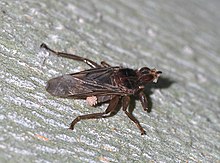Taxonomy
Hippoboscidae
EOL Text
Collection Sites: world map showing specimen collection locations for Hippoboscidae![]()
Robust more or less dorsoventrally flattened flies, 1.5-12.0 mm long, usually dull with variable and poorly defined pale markings, and richly setose. Antenna and mouthparts highly specialized. Wing usually fully developed, rarely reduced or absent. Abdomen, particularly in female, mainly membranous. Aedeagus and gonopods of male simple, retracted into abdomen when at rest. Larva completing development in uterus of female. (Maa & Peterson 1987)
| License | http://creativecommons.org/licenses/by/3.0/ |
| Rights holder/Author | Irina Brake, The Diptera Site |
| Source | http://diptera.myspecies.info/node/9767 |
Hippoboscidae, the louse flies or keds are obligate parasites of mammals and birds. In this family there are winged species which can fly at least reasonably well, as well as others with vestigial or no wings which are flightless and highly apomorphic. As usual in their superfamily Hippoboscoidea, most of the larval development takes place within the mother's body, and pupation occurs almost immediately.[2]
The sheep ked, Melophagus ovinus, is a wingless, reddish-brown fly that parasitizes sheep. The Neotropical deer ked, Lipoptena mazamae, is a common ectoparasite of white-tailed deer (Odocoileus virginianus) in the southeastern United States. Both winged and wingless forms may be seen. A common winged species is Hippobosca equina, called "the louse fly" among riders. Species in other genera are found on birds, for example, Ornithomya bequaerti has been collected from birds in Alaska. Two species of Hippoboscidae – Ornithoica (Ornithoica) podargi and Ornithomya fuscipennis are also common parasites of the Tawny Frogmouth (Podargus strigoides) of Australia.
Pseudolynchia canariensis is commonly found on pigeons and doves, and can serve as the vector of pigeon malaria. There is some evidence that other Hippoboscidae can serve as vectors of disease agents to mammals.
Systematics[edit]
In some obsolete taxonomies, the name Hippoboscidae is applied to the group properly known as Pupipara, i.e. the present family plus the bat flies (Nycteribiidae and "Streblidae"). It has been shown that two of the three traditional subfamilies (Hippoboscinae and Lipopteninae) are good monophyletic groups at least by and large. According to cladistic analysis of several DNA sequences, to make the Ornithomyinae monophyletic their tribe Olfersini deserves to be recognized as a full-blown family too.[3][4]
- Subfamily Ornithomyinae Bigot, 1853
-
- Genus Allobosca Speiser, 1899 (1 species)
- Genus Austrolfersia Bequaert, 1953 (1 species)
- Genus Crataerina von Olfers, 1816 (8 species)
- Genus Icosta Speiser, 1905 (52 species)
- Genus Microlynchia Lutz, 1915 (4 species)
- Genus Myophthiria Róndani, 1875 (13 species)
- Genus Olfersia Leach, 1817 (7 species)
- Genus Ornithoctona Speiser, 1902 (12 species)
- Genus Ornithoica Róndani, 1878 (24 species)
- Genus Ornithomya Latreille, 1802 (29 species)
- Genus Ornithophila Róndani, 1879 (2 species)
- Genus Ortholfersia Speiser, 1902 (4 species)
- Genus Phthona Maa, 1969 (3 species)
- Genus Proparabosca Theodor & Oldroyd 1965 (1 species)
- Genus Pseudolynchia Bequaert, 1926 (5 species)
- Genus Stilbometopa Coquillett, 1899 (5 species)
- Subfamily Hippoboscinae
-
- Genus Hippobosca Linnaeus, 1758 (7 species)
- Genus Struthibosca Maa, 1963 (1 species)
- Subfamily Lipopteninae
-
- Genus Lipoptena Nitzsch, 1818 (30 species)
- Genus Melophagus Latreille, 1802 (3 species)
- Genus Neolipoptena Bequaert, 1942 (1 species)
See also[edit]
References[edit]
- ^ Maa, T. C. (1969). "A Revised Checklist and Concise Host Index of Hippoboscidae (Diptera)". Pacific Insects Monograph (Honolulu: Bishop Museum, Honolulu, Hawaii) 20: 261–299.
- ^ Hutson, A.M (1984). Diptera: Keds, flat-flies & bat-flies (Hippoboscidae & Nycteribiidae). Handbooks for the Identification of British Insects. 10 pt 7. Royal Entomological Society of London. p. 84.
- ^ Petersen, Frederik Torp; Meier, Rudolf; Kutty, Sujatha Narayanan & Wiegmann, Brian M. . (October 2007). "The phylogeny and evolution of host choice in the Hippoboscoidea (Diptera) as reconstructed using four molecular markers.". Molecular Phylogenetics and Evolution 45 (1): 111–122. doi:10.1016/j.ympev.2007.04.023. PMID 17583536.
- ^ Dick, C. W. (20 December 2006). "Checklist of World Hippoboscidae (Diptera: Hippoboscoidea)" (PDF). Chicago: Department of Zoology, Field Museum of Natural History.
| License | http://creativecommons.org/licenses/by-sa/3.0/ |
| Rights holder/Author | Wikipedia |
| Source | http://en.wikipedia.org/w/index.php?title=Hippoboscidae&oldid=591651644 |
Barcode of Life Data Systems (BOLD) Stats
Specimen Records:478
Specimens with Sequences:443
Specimens with Barcodes:439
Species:31
Species With Barcodes:31
Public Records:94
Public Species:27
Public BINs:27

